Abstract
This study evaluates the socioeconomic effects of educational policies implemented between 2010 and 2024 within the context of the Fourth Industrial Revolution, focusing on the labor demand for professionals with advanced competencies. Using a quantitative analysis based on microdata from the National Survey of Occupation and Employment (ENOE) for 2010–2024, an econometric model is employed to estimate the returns to education and work experience and analyze gender wage gaps and the urban–rural distribution. The findings reveal a 46.3% increase in the labor market participation of individuals with higher education and a rise in wage disparities, particularly in the Information and Communication Technology sector. Limited to ENOE data in Mexico, this research adds value by identifying the mismatch between educational supply and emerging labor market demands. The conclusions suggest adjusting educational policies to reduce gender gaps and better equip graduates to meet current challenges.
JEL Classification:
I25; J31; O33
1. Introduction
Education has undergone a significant evolution, under the influence of globalization and technological advancements, particularly within the framework of the Fourth Industrial Revolution (). Higher education institutions (HEIs) face the challenge of integrating new technologies into teaching processes, meeting labor market demands, and aligning with public educational policies. In Mexico, these transformations are guided by strategies such as the National Development Plan and the Education Sector Plan (PSE), which aim to strengthen the role of Information and Communication Technologies (ICTs) in the professional and academic training of the population ().
Since 2000–2006, educational policies have emphasized the importance of ICTs, promoting flexible teaching modalities such as open and virtual education (). However, despite these advances, significant gaps in access to and the quality of higher education persist, particularly in less developed regions of the country (). Evaluating the impact of these policies is essential to understanding their contribution to socioeconomic development and social mobility, especially in a context where individuals invest in education to access better job opportunities and higher incomes ().
The PSE 2020–2024 was designed with six priority objectives, broken into 30 main strategies (). These strategies include 274 concrete actions implemented during this period to achieve the educational goals of the Fourth Transformation, led by former President Andrés Manuel López Obrador. This transformation, closely linked to the Industrial Revolution, aims to modernize and improve education to address contemporary socioeconomic challenges.
This context highlights how individuals voluntarily invest in their professional education to enhance their chances of entering the labor market, increase productivity, and achieve higher incomes compared to those with lower levels of education. The relevance of this approach is evident in the reconfiguration of productive factors in the education sector, as well as in the global advances and trends observed in industrial and service sectors, particularly under the Industry 4.0 paradigm. Industry 4.0 refers to the integration of digital technologies, automation, and data-driven processes into industrial and service operations, fundamentally transforming productivity and workforce skill requirements (; ). This paradigm is relevant to the study as it underscores the critical role of higher education in preparing individuals for the evolving demands of modern labor markets.
This research adopts a longitudinal design that allows for data to be collected during the implementation educational policies. The objective is to evaluate the socioeconomic effects of policies implemented by the government between 2010 and 2024 on various segments of the population. To achieve this objective, the following research question is posed: What is the socioeconomic impact of educational policies on different population segments?
This study’s methodology is based on a quantitative approach to assessing the socioeconomic effects of educational policies implemented from 2010 to 2024. To address the research question posed above, this study focuses on the determinants of labor market remuneration for the human capital supplied by the country’s universities, employing the Mincerian model methodology as the analytical framework. Additionally, the analysis includes an estimation of rates of return to education, which measures the incremental income associated with each additional year of schooling. This allows for a comprehensive evaluation of the economic benefits of education and the factors influencing wage differentials across different fields of study, gender, and geographic region.
The structure of this paper is organized as follows: After the introduction, a literature review is presented. Subsequently, this study’s methodology is detailed, followed by an estimation and analysis of the results. Finally, the main conclusions are discussed, and references are provided.
2. Literature Review
From an educational demand perspective, the literature supports that education significantly contributes to income increases compared. This effect is explained by the concept of human capital, which, according to () and the (), highlights how investments in skills and knowledge enhance individuals’ productive capacity, establishing a clear link between education and economic development. () expand on this discussion by emphasizing that technological advancements have intensified the demand for advanced skills, positioning higher education as a critical factor in global economic competitiveness.
This study delves into the transformative impact of technological advancements on the education sector. The increase in distance learning and the advent of artificial intelligence have reshaped the educational landscape, as highlighted by (). The prominence of online learning platforms in higher education has ushered in new teaching methods that cater to diverse learning needs and significantly enhance the accessibility of education. The author discusses how online learning leads to e-learning at higher education institutions, providing insights into the effectiveness and challenges of integrating technology into academic settings. This shift towards digital learning environments aligns with the broader trends observed in the Industry 4.0 paradigm, where technology plays a pivotal role in the economic and social sectors.
Another significant change shaping the demand for higher education and the workforce patterns is the emergence of Generation Z. This generation, characterized by a pragmatic mindset and a preference for quick satisfaction with minimal effort, shows a different approach to education and employment. () explore whether the younger generation is a driving force toward achieving sustainable development goals, emphasizing their distinct perceptions of employment and the value they place on higher education. Understanding these generational shifts is crucial for aligning educational policies with the evolving needs of the labor market.
Before delving into the specifics of Mexican educational policies, it is essential to consider the higher education reforms and regulations of other countries. These reforms often aim to strengthen the connection between education systems and local labor markets. () provide a significant example from Israel, discussing how academia is regulated through legislation, public policies, and market forces. Their analysis highlights efforts to align higher education with the country’s economic needs, ensuring that educational programs meet labor market demands. They emphasize the impact of these policies on the quality of education and the autonomy of academic institutions, reflecting a global trend toward creating more integrated and market-oriented educational systems.
In the case of Mexico, the International Standard Classification of Education by (, ) and the Mexican classification of study programs () can be used to investigate whether skilled professional employment derived from higher education (tertiary education) has experienced notable growth. According to data from the National Survey of Occupation and Employment (ENOE), the Mexican labor market included 5.2 million workers with a professional degree in 2010, which increased to 7.6 million by 2024 (), reflecting a 46.3% rise.
These changes align with a labor market that prioritizes technical and scientific training, addressing the demands of a globalized, knowledge-based economy (). However, fields like Natural Sciences, Mathematics, Statistics, and Information and Communication Technologies (ICTs) showed a relative decline in participation, highlighting challenges in the creation of educational policies that foster technological and scientific innovation (). This is particularly relevant in contexts like Mexico, where significant inequalities persist in access to higher education. From 2010 to 2024, the Mexican labor market experienced a significant transformation in the distribution of workers with higher education in various academic fields, reflecting shifts in labor demand and educational policies.
According to (), the proportion of graduates in the field of Education decreased from 16.8 to 12.7%. In contrast, fields such as Engineering, Manufacturing, and Construction increased from 11.4 to 17.2%, and the field of Health Sciences grew from 7.4 to 9.9%. These trends are indicative of the Fourth Industrial Revolution, which emphasizes the integration of advanced technologies and drift-driven processes into industries and services. This underscores the importance of adjusting public policies to balance academic training with labor market needs, promoting economic development and social mobility (; ; ).
Beyond economic effects, higher education is critical in building a nation’s social and cultural capital. According to (), education enhances individuals’ productive capacity and fosters social cohesion by enabling diverse population sectors to access knowledge and innovation networks. This is particularly relevant in Mexico, where educational policies have sought to reduce historical inequalities in access to education (). The global context significantly influences Mexico’s academic policies, emphasizing the importance of strengthening education systems in emerging economies to achieve sustainable development goals, particularly regarding equity and educational quality (; ). This positions Mexico as a critical case for analyzing the socioeconomic effects of such policies in a dynamic and globalized environment.
In this framework, comprehensive strategies that consider both local demands and international trends are essential. () state that effective educational policies must align with sustainable development goals by promoting human capital formation, innovation, social inclusion, and sustainability. For Mexico, this entails prioritizing strategic fields such as Engineering, Information Technologies, and Health Sciences while fostering a holistic education that prepares graduates for an ever-changing labor market.
3. Methodology
This section employs the Mincer model to analyze the returns to human capital in the labor market, given its widespread use and empirical validity in studies on rates of return to education (; ; ). This model captures how sociodemographic characteristics influence wages, aligning with the literature reviewed in previous sections. Additional geographic locations were included to evaluate structural inequalities and wage differentials.
For the estimation, microdata from the ENOE for 2010 and 2024 were used, and a sample of workers with higher education was selected. The Ordinary Least Squares (OLS) method was applied, verifying the assumptions of normality and heteroskedasticity. The variables included in the model, along with their theoretical justification, were as follows: education, experience, hours worked, gender, and geographic location. These variables enabled an exploration of how factors such as human capital accumulation (education and experience) and demographic characteristics affect wages.
A descriptive analysis is presented in the tables, showing distributions by gender and field of knowledge, followed by the econometric results. Additionally, the model’s hypotheses were validated to ensure that the estimated coefficients accurately reflected the expected relationships among the variables. The following Mincer equation was used to estimate log salary functions by field of knowledge:
for i = 1, …, n and j = 1, …, 10.
Where is a logarithm of the wage of worker i; is the years of schooling of the individual i; is the years of experience of the individual i; is the hours worked per week by the individual i; is the binary variable for the gender (1 if male, 0 if female) of the individual i; is a binary variable for the location (1 if urban, 0 if rural) of the individual i; and is the error term for the individual i.
The hypotheses to be validated were as follows:
- : the average salary increases with each additional year of schooling when all other variables are kept constant.
- : the average salary increases with each additional year of experience when all other variables are kept constant.
- : salaries show diminishing returns after a critical point, meaning that salaries stop increasing and begin to decrease as years of experience increase.
- : the average salary increases with each additional hour worked when all other variables are kept constant.
- : on average, men earn higher wages than women when all other variables are kept constant.
- : workers in urban areas earn higher wages than those in rural areas when all other variables are kept constant.
This analysis used descriptive exploration and an econometric estimation for 2010 and 2024, using samples of workers earning wages and possessing all the defined sociodemographic characteristics.
4. Results
4.1. Distribution of the Workforce by Gender and Age Groups by Field of Knowledge
The Mexican labor market for workers with higher education has seen a notable increase in female participation, particularly over the past 14 years. Between 2010 and 2024, the proportion of women in the workforce rose from 43.4 to 48.8%, while male participation decreased from 56.6 to 51.2%. Workers over 60 years old increased across both genders, with the most significant growth observed among women, especially in the 30- to 79-year-old age group, where their participation doubled that of men (see Table 1).

Table 1.
Workforce with higher education by field of knowledge.
In the field of Education, the total workforce grew by 10.4% between 2010 and 2024, driven primarily by a 15.7% increase in female participation, while male participation slightly declined, by 0.4%. This shift reflects the consolidation of female representation in the sector, particularly among individuals aged 20 to 59, where women experienced a significant 111.1% increase compared to a 15.6% decline in male participation within the same age range.
Men and women over 60 significantly increased their presence in the education sector. Women over 60 nearly tripled their participation, rising from 9000 to 24,000, while men in this age group nearly quadrupled, increasing from 6000 to 23,000. This trend may be linked to the excellent retention of older workers in the sector, possibly due to their accumulated experience and the employment stability in this field. Despite these increases, the most significant transformation was observed in the younger age groups, cementing women as a vital segment of the workforce in the field of Education (see Figure 1).
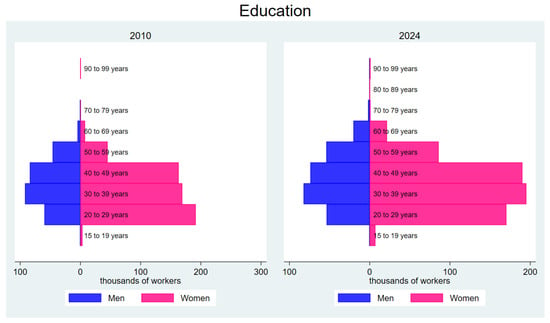
Figure 1.
Distribution of the workforce by gender and age in the field of Education.
In the Arts and Humanities field, the number of workers with bachelor’s degrees grew by 65.6% between 2010 and 2024, accompanied by a shift in gender composition. Female participation increased from 48.5 to 51.1%, while male participation decreased from 51.5 to 47.9%, reflecting the more significant gender equity in this sector. Men under 70 experienced both absolute and relative growth in their participation, strengthening their presence in productive age groups. On the other hand, women over 70 saw a decline in their participation, possibly linked to the aging of the workforce and the market limitations faced by this demographic (see Figure 2).
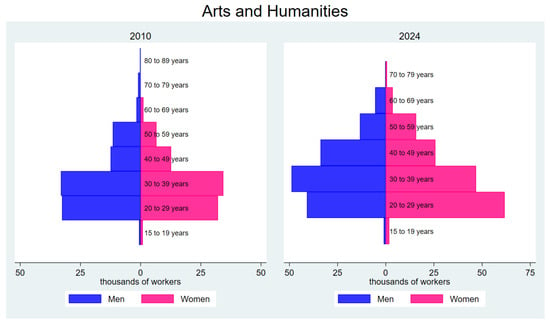
Figure 2.
Distribution of the workforce by gender and age in the field of Arts and Humanities.
The graph also indicates a trend toward incorporating younger generations, with a notable growth in participation by women aged 20 to 29, suggesting that educational and labor policies have facilitated their inclusion in this field. At the same time, representation among older age groups (60 years and above) remains limited, possibly related to the demand for updated skills and the transition to a younger workforce.
In Figure 3, which focuses on Social Sciences and Law, the workforce with a bachelor’s degree grew by 48.4% between 2010 and 2024, with increases observed across both genders and across all age groups. This growth was accompanied by a shift in gender distribution: female participation rose from 49.9 to 56.2%, while male participation decreased from 50.1 to 43.8%. This shift highlights the increasing female representation in the field, with women being the predominant group in 2024.
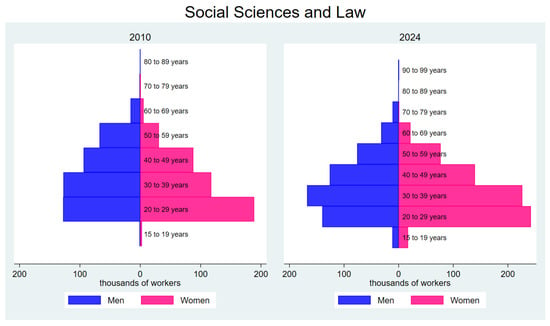
Figure 3.
Distribution of the workforce by gender and age in the field of Social Sciences and Law.
An age group analysis revealed that the growth was primarily driven by younger populations, particularly among individuals aged 20 to 59, with an average increase of 45.8%. This increase was more pronounced among women (82.2%) than men (21.9%). Among those aged 60 and older, growth exceeded 300% for both genders, indicating an extension of professional careers in this field, potentially tied to the accumulation of experience and the job stability this sector provides. The figure underscores a trend of generational and gender inclusion, reflecting a structural evolution in the labor market within the field of Social Sciences and Law.
In the field of Administration and Business, the workforce with a bachelor’s degree grew by 48.3% between 2010 and 2024. A significant shift in gender composition accompanied this growth: the proportion of male workers decreased from 54 to 46.8%. In comparison, female participation increased from 46 to 53.2%, establishing women as the majority group in this field by 2024.
The growth in female participation was more than double that of men across all age groups over 20 years old, with particularly notable increases among older adults. This reflects the more active inclusion of women in the labor market, likely driven by gender equity policies and increased educational and employment opportunities in the Administration and Business sectors. The graph also highlights that age groups between 20 and 39 years account for a significant portion of the growth, emphasizing the role of younger generations in driving the structural transformation of this field (see Figure 4).

Figure 4.
Distribution of the workforce by gender and age in the field of Administration and Business.
The total number of workers in the fields of Natural Sciences, Mathematics, and Statistics decreased by 31.1% between 2010 and 2024. This decline affected all age groups except young women (20 to 29 years) and older women (60 years and above), who experienced a slight increase in participation. This shift suggests a potential generational and gender transition within the sector.
Regarding gender composition, male participation dropped from 61% in 2010 to 50% in 2024, resulting in a more balanced gender distribution. This shift reflects the increased inclusion of women in a field historically dominated by men. However, the overall reduction in the workforce in this sector may be linked to decreased demand or a transition toward other fields related to technology and innovation, which have shown higher growth rates (see Figure 5).
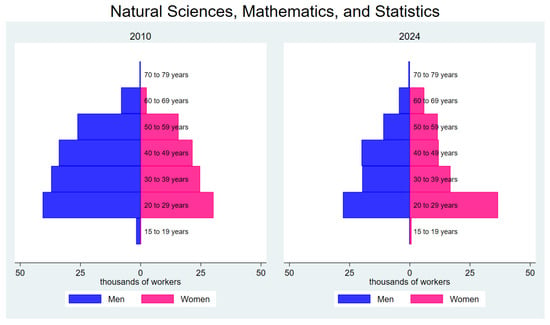
Figure 5.
Distribution of the workforce by gender and age in the fields of Natural Sciences, Mathematics, and Statistics.
As shown in Figure 6, the field of ICT experienced an overall growth of 17.9% between 2010 and 2024. This increase was primarily driven by the 30- to 59-year-old age group, which experienced a growth exceeding 100%, indicating a consolidation of the workforce within productive and experienced age ranges. This trend suggests that the ICT labor market prioritizes retaining workers at different stages of professional maturity.
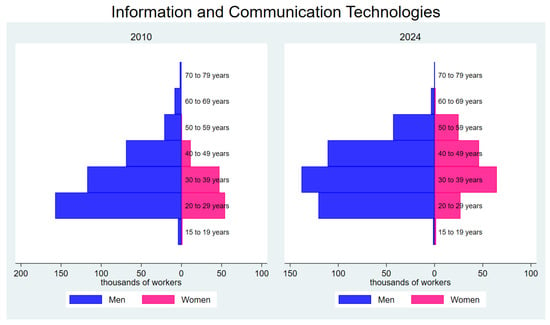
Figure 6.
Distribution of the workforce by gender and age in the field of ICT.
By contrast, populations under 30 and over 60 experienced an average decline of 52.5%, potentially reflecting challenges in integrating new young talent and the early exit of older workers. While men continue to dominate in absolute numbers, there has been a slight improvement in female representation in the younger and middle-aged groups, indicating a trend toward the greater inclusion of women in this historically male-dominated sector. The graph highlights the reconfiguration of the ICT labor market, which is focusing on a core of experienced workers and facing difficulties in attracting and retaining both young talent and late-stage professionals.
In the fields of Engineering, Manufacturing, and Construction, the workforce with a bachelor’s degree grew by 119.8% between 2010 and 2024, establishing this sector as among those with the largest rate of expansion. This growth was primarily driven by the 20- to 39-year-old age group, where female participation quadrupled, reflecting significant progress in including women in a traditionally male-dominated field. In the same age range, male participation doubled, maintaining their predominance in absolute terms.
Older age groups, particularly those over 60, also experienced growth, albeit at a lower rate, indicating the gradual aging of the workforce in this sector. This trend may be associated with older groups’ accumulated technical experience and job stability in this field. The graph illustrates a structural transformation in the sector, characterized by a rejuvenation of productive age groups and a greater incorporation of women. This underscores the importance of policies promoting inclusion and retaining young and experienced talent in the fields of Engineering, Manufacturing, and Construction (see Figure 7).
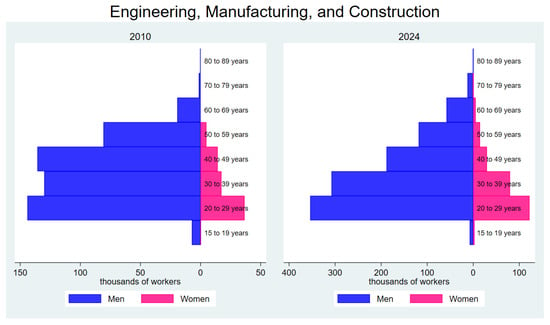
Figure 7.
Distribution of the workforce by gender and age in the fields of Engineering, Manufacturing, and Construction.
In the fields of Agronomy and Veterinary Medicine, the workforce with higher education grew by 12.5% in absolute terms between 2010 and 2024. This growth was primarily driven by a remarkable 93.9% increase in the participation of women, whose initial participation was low in 2010 (11.8%). By contrast, men, who constituted most of the workforce in 2010 (88.2%), experienced a much smaller relative growth of 1.6% owing to their high initial level of representation.
Visually, this can be reflected in a significant increase in female representation, particularly in the 20- to 29-year-old age group, where women markedly expanded their participation. Although the absolute number of men also increased slightly, the low growth percentage indicates that the most substantial transformation occurred among women, leading to a redistribution of gender composition: by 2024, men represented 79.7%, and women represented 20.3% of the total workforce (see Figure 8).
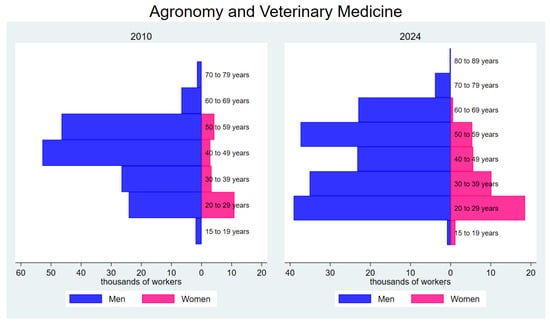
Figure 8.
Distribution of the workforce by gender and age in the fields of Agronomy and Veterinary Medicine.
In the field of Health Sciences, the employed population grew by a remarkable 97.6% between 2010 and 2024, with a particularly significant increase in female participation. The proportion of women in this sector rose from 55.2 to 69.2%, while the share of men declined from 44.8 to 30.8%. This shift reflects the growing feminization of the sector, driven by a 147.6% increase in the number of female workers compared to a more moderate 35.9% increase among men.
The graph shows that women’s growth was most pronounced in the younger and middle-aged groups, particularly in the 20- to 39-year-old age range, where women became the predominant group. By contrast, men experienced a more evenly distributed growth across age groups, with lower representation in the younger segments. These data highlight the structural transformation of the Health Sciences sector, driven by the increasing participation of women in a field critical to social and economic development, as illustrated in Figure 9.
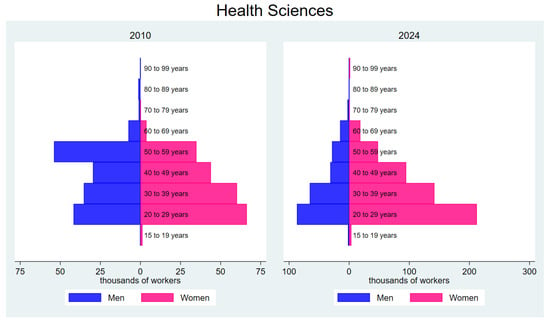
Figure 9.
Distribution of the workforce by gender and age groups in the field of Health Sciences.
In the Services field, the total workforce grew by 33.2% between 2010 and 2024, with a significantly greater increase among women (54.5%) compared to men (14.7%). This shift resulted in a reversal of the gender composition: while men accounted for 53.6% and women accounted for 46.4% of the total workforce in 2010, by 2024, women became the majority group at 53.8%, surpassing men, who decreased to 46.2%.
The 20- to 39-year-old age group experienced the most significant growth, with a 47.1% increase, establishing itself as the core workforce in this sector. By contrast, participation among individuals under 20 and those over 60 was limited or declined. This pattern reflects a growing preference and demand for skills in the 20–39 age range. It highlights the transition toward more significant gender equity in a field that has historically been dominated by men in certain areas, such as transportation and military services (see Figure 10).
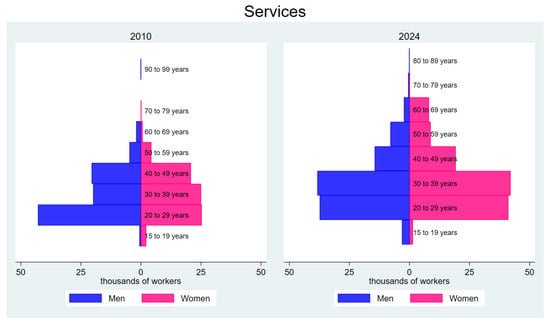
Figure 10.
Distribution of the workforce by gender and age in the field of Services.
4.2. Descriptive Statistics in the Labor Market According to Field of Knowledge
Table 2, showing descriptive statistics for 2010, provides a comprehensive overview of workers’ wages, as well as their sociodemographic and labor characteristics, across various fields of knowledge in Mexico.

Table 2.
Descriptive statistics by field of knowledge for 2010.
Significant differences in wages are observed across different areas of study. The Engineering, Manufacturing, and Construction field leads, with an average monthly salary of MXN 10,456.98, reflecting the high demand for this profile in the labor market. Natural Sciences, Mathematics, and Statistics follow, with an average of MXN 9854.94. By contrast, the Services field reports the lowest average salary, at MXN 7073.59, suggesting a lower perceived value of these occupations by employers.
Regarding work experience, workers in the Education field have the highest average experience (16.17 years), likely due to the extended career paths often required for teaching or administrative positions. Conversely, the Arts and Humanities field has the lowest average experience (11.78 years), which may be related to this sector’s fragmented or flexible career trajectories.
Regarding working conditions, weekly hours worked vary slightly across fields, ranging from 38 to 41 h. However, the Health Sciences sector stands out with the highest average of 41.77 h per week, reflecting this profession’s demands and inherent rigor. This field was also shown to have a higher workload compared to others.
The analysis of gender distribution reveals significant inequalities. In technical fields such as Engineering and Natural Sciences, men dominate, with proportions of 0.6892 and 0.7045, respectively. By contrast, the proportion of men working in the field of Education is much lower (0.3328), indicating a predominance of women in this sector. This gender segmentation underscores the need for policies promoting the greater inclusion of women in traditionally male-dominated fields.
Finally, the concentration of workers in urban areas is consistent across all fields of knowledge, reinforcing the hypothesis of limited access to job opportunities for professionals in rural areas. This urban–rural divide highlights structural inequalities that could impact the rates of return on investment in human capital across different regions.
Table 3, showing descriptive statistics for 2024, provides a detailed overview of workers’ wages, as well as their sociodemographic and labor characteristics, across various fields of knowledge. Regarding income, the Engineering, Manufacturing, and Construction field leads, with an average monthly salary of MXN 15,891.97, followed closely by Administration and Business, at MXN 13,897.96. Conversely, the field with the lowest average salary is Services, at MXN 12,007.18. While lower than other fields, this represents a general improvement over the salary levels observed in 2010, reflecting significant growth in average remuneration across all fields, potentially linked to sustained economic development.

Table 3.
Descriptive statistics by field of knowledge for 2024.
Regarding work experience, the average years of work experience vary considerably by field. Health Sciences has the highest average, at 19.1 years, likely due to the prolonged nature of career paths in this sector, including training and specialization processes. By contrast, workers in ICT report the lowest average, at 14.83 years, reflecting the recent incorporation of workers into a dynamic and rapidly growing sector.
Concerning working hours, weekly hours are relatively uniform across fields, ranging between 37 and 42 h on average. Services stands out with the highest average, at 40.9 h per week, which may reflect the high time demands of this sector. This pattern aligns with observations from 2010, where sectors such as Health Sciences also showed elevated workloads.
Finally, the geographic distribution of workers remains predominantly urban, reinforcing the 2010 findings regarding the limited access to job opportunities for professionals with higher education in rural areas. This highlights the need for policies that expand employment opportunities outside urban centers, particularly in high-demand sectors like Engineering or Health Sciences.
Our statistical analysis revealed the following transformations between 2010 and 2024:
- (a)
- Wage CompensationThe analysis of wage data shows a significant increase in the average earnings of professionals with tertiary education between 2010 and 2024. The average monthly salary rose from MXN 8418 in 2010 to MXN 13,625 in 2024, representing a 61.8% increase. This growth highlights the increase in human capital valuation in the labor market during this period. The income threshold for the top 25% of the workforce also rose significantly, from MXN 10,000 or more per month in 2010 to MXN 16,000 or more in 2024, indicating a widening difference in the distribution of wages toward higher levels.Across specific fields of knowledge, all sectors experienced notable wage increases. The fields of Engineering, Manufacturing, and Construction reported the highest average salaries in both years, rising from MXN 10,547 in 2010 to MXN 15,892 in 2024. This trend reflects the high demand for technical and industrial production professionals. ICT recorded the second-highest increase, reaching an average of MXN 14,620 in 2024, driven by growing digitalization and technological transformations. In contrast, Services, despite doubling its average salary (from MXN 6074 to 12,007), remains the field with the lowest earnings, indicating a lower valuation of occupations in this field in terms of wages.Wages in fields such as Education (MXN 7441 to 11,766) and Social Sciences and Law (MXN 8296 to 12,843) also significantly improved. However, their average salaries remain below those in technical fields like Engineering and ICT. This disparity suggests structural differences in the perceived value of these disciplines within the labor market.
- (b)
- EducationThe analysis of educational attainment showed that the average years of schooling among workers with a bachelor’s degree remained stable between 2010 and 2024, with a minimum average of 16 years, corresponding to a completed undergraduate degree. While the average level of education has not changed significantly, the increases observed in specific occupational fields reflect greater specialization, driven by the increase in postgraduate degrees such as masters and doctorates. This trend suggests that some sectors of the labor market of 2024 require higher academic qualifications than they did in 2010, aligning with the needs of a more competitive and specialized market.Additionally, there has been an increase in the proportion of the workforce with higher education, particularly among the 19- to 59-year-old age group. This growth may be attributed to educational policies that have expanded access to higher education and shifts in labor market dynamics, which increasingly value tertiary education. The growing participation of young adults with advanced studies highlights the importance of education in improving job opportunities and reflects a trend toward the professionalization of Mexico’s workforce. However, this phenomenon also raises the question of whether this increase in the level of educational attainment is being fully rewarded in terms of wages and working conditions.
- (c)
- Potential Work ExperienceBetween 2010 and 2024, the average work experience required by the labor market for professionals with a bachelor’s degree varied across fields of knowledge. In areas such as Education, Arts and Humanities, Social Sciences and Law, Administration and Business, ICTs, Agronomy and Veterinary Medicine, and Services, an increase in the average experience demanded was observed. This trend may be linked to greater professionalization or the need for accumulated practical skills in these sectors, reflecting a shift toward labor markets that place more value on their workers’ professional trajectories.By contrast, fields such as Natural Sciences, Mathematics, and Statistics, Engineering, Manufacturing, and Construction, and Health Sciences experienced a decline in the average experience required.This phenomenon may indicate that these sectors prioritize innovation and specific skills over accumulated experience or are attracting a younger workforce due to the rapid pace of technological transformation or shifts in labor market priorities.
- (d)
- Weekly Hours WorkedThe average weekly hours worked by professionals with bachelor’s degrees remained stable, at 39 h, between 2010 and 2024. However, when broken down by fields of knowledge, significant variations emerge, reflecting the specific dynamics within each sector. For instance, in the field of Education, the average weekly hours increased from 27 to 29, likely due to greater responsibilities or academic workloads stemming from educational reforms and the increased demands placed on the school system. Similarly, in the field of Arts and Humanities, the average grew weekly hours from 35 to 36 h, which is potentially linked to the increased professionalization within the sector.Conversely, fields such as Administration and Business, Engineering, Manufacturing, and Construction, and Agronomy and Veterinary Medicine experienced slight reductions in the average hours worked, dropping from 42 to 41 h, 44 to 43 h, and 43 to 40 h, respectively. This decline could be related to the expansion of the workforce in these areas, potentially redistributing workloads among more of workers. Similarly, fields like Natural Sciences, Mathematics, and Statistics and Health Sciences saw marginal decreases in average hours, which may reflect efforts to balance work schedules or increase workplace flexibility within the labor market.
- (e)
- GenderBetween 2010 and 2024, the participation of the female labor force with a bachelor’s degree in the professional market increased significantly, from 44 to 48%. This trend reflects progress toward more significant gender equity in professional sectors, with variations across fields of knowledge. Notably, fields such as Engineering, Manufacturing, and Construction saw a significant rise in female participation, from 13 to 20%, as well as the fields of Agronomy and Veterinary Medicine, which saw an increase from 12 to 22%, indicating advances in integrating women into traditionally male-dominated sectors.In the field of Education, male participation declined slightly, from 33 to 30%, reinforcing the predominance of women in this field. Similarly, in the fields of Social Sciences and Law, female participation grew from 50 to 57%, establishing this as one of the areas with the highest representation of women. Conversely, sectors like ICT saw only a marginal increase in female participation, from 42 to 43%, highlighting persistent challenges in achieving gender balance in this domain.A significant increase was also observed in the Health Sciences, where female participation rose from 60 to 68%, reflecting a more substantial presence of women in care-related and medical fields. By contrast, male participation declined in fields like Natural Sciences, Mathematics, and Statistics, dropping from 60 to 50%, suggesting a leveling of gender representation in these areas.
- (f)
- Urban and Rural ZonesThe geographical distribution of workers with bachelor’s degrees reveals an intense concentration in urban areas in 2010 and 2024, although a slight decline was observed. In 2010, 95.5% of professionals worked in urban areas, which decreased to 94.3% in 2024. Conversely, rural areas housed 4.5% of professionals in 2010, with this increasing to 5.7% in 2024. Although modest, this increase reflects a trend toward the greater integration of professionals in rural areas, likely driven by decentralization policies and the strengthening of specific regional sectors.Among the fields of knowledge, Education and Services showed an increased professional presence in rural areas between 2010 and 2024. This may be attributed to the nature of these sectors, which often see higher demand in less urbanized areas due to the need for teachers and essential service providers in rural communities. By contrast, fields such as Engineering, Manufacturing, and Construction and ICT maintained their relatively low levels of participation in rural areas, reflecting the dominance of urban centers in providing job opportunities for these disciplines.
4.3. Rates of Return to Education in the Labor Market by Field of Knowledge and Gender
The results of the econometric model estimated for 2010 and 2024 indicated a decline in the rate of return to education, with this decreasing from 14.5% in 2010 to 11.5% in 2024. This reduction of over three percentage points may be attributed to the growth in the supply of professionals with higher education, potentially leading to saturation in some labor markets, particularly at the regional level. The decline may also reflect the reduced wage differentiation for individuals with university degrees compared to previous years, driven by changes in labor market demands.
An analysis of the fields of knowledge reveals significant differences. The highest returns to education in both periods were observed in areas such as Engineering, Manufacturing, and Construction, followed by ICTs and Administration and Business. This indicates a strong relationship between these disciplines and the highly valued skills employers seek. By contrast, fields like Services, Health Sciences, and Arts and Humanities show lower returns, reflecting a lower valuation in terms of wages for these sectors.

Table 4.
Estimated coefficients for 2010. Dependent variable: log(monthly salary).

Table 5.
Estimated coefficients for 2024. Dependent variable: log(monthly salary).
The overall rate of return to schooling decreased from 2010 to 2024, from 14.5 to 11.5 percent. The fields of knowledge that presented the highest return rates were Natural Sciences, Mathematics, and Statistics, Engineering, Manufacturing, and Construction, and Health Sciences. However, in all fields except Education and ICT, the rate of return to schooling increased by between 1 and 3 percentage points. Return to experience decreased in all fields except Services, where it increased from 2.52 to 4.12 percent. Hours worked contribute an additional one percent to performance compared to salary and showed small variations from 2010 to 2024 in all fields of knowledge.
The salary differential between men and women increased in all fields of knowledge, from 12 to 18 percent in general, except in Agronomy and Veterinary Medicine. In Education, the wage gap increased from 4.7 to 8.6 percent; in the Arts and Humanities, it increased from 1.7 percent in favor of women to 6.6 in favor of men; in Social Sciences and Law, the salary gap increased from 14 to 18 percent; in Business and Administration, it increased from 15.7 to 18.1 percent; in the Natural Sciences, Mathematics, and Statistics, it increased from 18.9 to 22.4 percent; in Engineering, Manufacturing, and Construction, it increased from 12.8 to 17.5 percent; in ICT, it increased considerably from 11.9 to 25.8 percent; in Agronomy and Veterinary Medicine, it decreased from 30.9 to 21.3 percent; in Health Sciences, it increased from 11 to 13.5 percent; and finally, in Services, it increased from 17.5 to 19.4 percent.
Regarding the salary differential between urban areas and rural areas, in general, there was an increase from 16.3 percent in 2010 to 20.1 percent in 2024 in favor of rural areas compared to urban areas; in Education, the increase was from 8.2 to 8.9 percent; in Arts and Humanities, the salary differential increased from 11.2 to 19.9 percent; in Social Sciences and Law, it increased considerably from 10.9 to 26.4; in Administration and Business, it went from 24.8 to 23.6 percent; in Natural Sciences, Mathematics, and Statistics, it decreased from 28.2 to 18.6 percent; in ICTs, it increased from 13 to 21.7 percent; in Engineering, Manufacturing, and Construction, it increased from 20.7 to 22.2 percent; in Agronomy and Veterinary Medicine, it decreased from 27.5 to 21.8 percent; in Health Sciences, it decreased from 15.9 to 18.1 percent; and finally, in Services, it decreased from 33.8 to 11.9 percent (Figure 11).
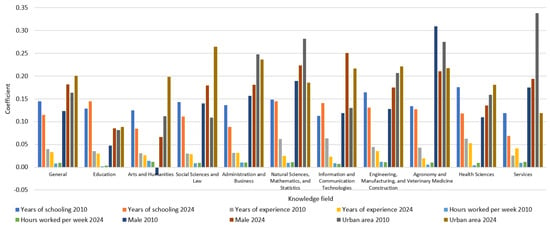
Figure 11.
Estimated coefficients of log(monthly salary) functions, 2010–2024.
The significance of all estimators is indicated in Table 4 and Table 5 for the respective years of 2010 and 2024. The ENOE microdata samples are comparable for both years since they were collected through stratified random sampling through clusters, (, ). The OLS estimators satisfy the properties of consistency, showing that the data tend to be unbiased and have minimum variance because the samples were as large as possible, (). The variance in the errors is not constant across observations and the null hypothesis of homoscedasticity is rejected.
5. Discussion
This study provides evidence regarding the rates of return to education and wage differentials, building on the theoretical foundations of (), (), and (), while identifying emerging patterns in the Mexican labor market. A key contribution is the empirical validation of the human capital hypothesis, demonstrating that the rate of return to professional tertiary education remains positive across all fields but experienced a general decline, from 14.5% in 2010 to 11.5% in 2024. This phenomenon confirms the predictions of () and (), who suggested that expanding the educational supply could reduce returns due to saturation in specific labor markets. The observed increases in sectors such as Education and ICT highlight the strategic role of these areas in contemporary economic development, a trend also identified by ().
Another significant contribution of this paper is the estimation of diminishing returns to work experience, confirming the inverted U-shaped relationship proposed by classical human capital theories. This finding reinforces the emphasis of () on the need for policies that promote skill updates throughout one’s working life. The inclusion of quadratic variables in the econometric model demonstrates how income reaches a critical point, after which additional experience yields lower returns, highlighting the importance of designing continuous training programs. This idea is also supported by ().
From a gender perspective, this study documents increasing wage gaps, partially contradicting the expectation of convergence driven by the growth in female labor market participation. This phenomenon is particularly pronounced in technical fields such as ICT (where the gap widened from 11.9% to 25.1%) and Natural Sciences (18.9% to 22.4%), underscoring the need for strategies to close these disparities. In contrast, sectors such as Agronomy and Veterinary Medicine have shown improvements, with the gender gap narrowing from 30.9% to 21.3%, providing a positive case within a generally unequal landscape, supported by the analyses of ().
Finally, this work introduces a regional analysis by exploring urban–rural wage gaps, revealing an increase from 16.3% to 20.1%, although notable decreases were observed in fields such as Services (from 33.8% to 11.9%) and Natural Sciences (from 28.2% to 18.6%). This finding adds a critical geographical dimension to the literature, emphasizing the importance of policies that promote balanced regional development and reduce inequalities in access to skilled employment, as suggested by () in their studies on the regional impact of education.
Collectively, these contributions expand on and update the existing literature on the labor market and return to education in Mexico, providing a detailed analysis that combines economic, social, and regional aspects. The study highlights the need for public policies that can adapt to the changing dynamics of the market, fostering equity and sustainable development in a globalized context, aligned with the arguments of () and ().
6. Conclusions
The results of this study confirm the segmentation of the Mexican labor market, with significant imbalances between supply and demand across different fields of knowledge. These mismatches, as highlighted by (), result from a gap between the skills cultivated in higher education and the specific requirements of various occupations. This discrepancy leads to over- or undereducation in many sectors, particularly in fields such as engineering and technology, where the rapid advancements outpace curricular updates. To optimize human capital investments, it is crucial to implement dynamic curricula that can respond to the evolving labor market needs and to foster stronger partnerships between academia and industry.
The expansion of the economically active population with higher education, increasing from 5.2 million in 2010 to 7.6 million in 2024, reflects progress in access to tertiary education. However, this growth has not been uniform across all fields. While the fields of Administration and Business, Engineering, Manufacturing, and Construction, and Health Sciences experienced substantial growth, fields like Natural Sciences, Arts and Humanities, and Agronomy and Veterinary Medicine struggled to maintain labor market relevance. Targeted development strategies, such as incentivizing enrollment in underrepresented fields and aligning them with emerging market trends, are essential to address these disparities and ensure a balanced contribution to economic development.
From a gender perspective, the data indicate an increase in female participation, surpassing 50% in fields such as Engineering and Health Sciences. Significant wage gaps persist despite this progress, particularly in ICT, where the disparity in wages widened from 11.9% to 25.1%. This trend highlights an urgent need for public policies to close these wage gaps, such as enforcing equal pay laws and promoting gender-inclusive work environments. Moreover, the reducing gender disparities in sectors like Agronomy and Veterinary Medicine suggests that replicating successful equity strategies in other fields could further promote gender equality in the labor market.
The decline in the rate of return on higher education, from 14.5% in 2010 to 11.5% in 2024, reflects the increased labor market competition in specific fields and the aging population. This finding underscores the importance of fostering high-demand labor areas and updating workers’ skills through continuous education and retraining programs.
7. Recommendations for Educational Policy
Based on our findings, we make the following recommendations for educational policy:
- Alignment between education and labor market: Design policies that promote closer collaboration between HEIs and productive sectors, ensuring the curricula align with labor market demands.
- Promotion of gender equity: Implement fiscal incentives and awareness programs to reduce gender wage gaps, particularly in fields such as ICT and Engineering.
- Support for emerging sectors: Develop financing strategies and scholarships in low-growth areas, such as the Natural Sciences and Arts, to enhance their relevance in the national economy.
- Promotion of lifelong learning: Create training programs to help workers update their skills and adapt to evolving market demands, especially in the technical and scientific fields.
- Balanced regional development: Establish policies to reduce urban–rural disparities through providing incentives to create skilled jobs in rural areas and strengthening educational institutions in these regions.
Author Contributions
Conceptualization, J.Y.R.G.; methodology and software, J.F.I.A.; validation, J.F.I.A.; formal analysis and investigation, J.Y.R.G. and J.F.I.A.; data preparation, J.F.I.A.; writing—original draft preparation, J.Y.R.G. and J.F.I.A.; writing—review and editing, J.Y.R.G. and J.F.I.A. All authors have read and agreed to the published version of the manuscript.
Funding
This research was funded by Instituto Politécnico Nacional, grant number SIP20242247, and registered by Secretaría de Investigación y Posgrado, Instituto Politécnico Nacional.
Informed Consent Statement
Not applicable.
Data Availability Statement
The paper uses publicly available data. Sources and data are defined in Section 3.
Conflicts of Interest
The authors declare no conflicts of interest. The funders had no role in the design of the study; in the collection, analysis, and interpretation of data; in the writing of the manuscript; and in the decision to publish the results.
Abbreviations
The following abbreviations are used in this manuscript:
| INEGI | Instituto Nacional de Estadística y Geografía |
| ENOE | Encuesta Nacional de Ocupación y Empleo |
| ICTs | Information and Communication Technologies |
References
- Altbach, P. G., Reisberg, L., & Rumbley, L. E. (2019). Trends in global higher education: Tracking an academic revolution (Vol. 22). Brill Academic Publishers. [Google Scholar]
- Ayu, M. (2020). Online learning: Leading e-learning at higher education. The Journal of English Literacy Education: The Teaching and Learning of English as a Foreign Language, 7(1), 47–54. [Google Scholar] [CrossRef]
- Becker, G. S. (1975). Human capital: A theoretical and empirical analysis, with special reference to education (2nd ed.). National Bureau of Economic Research. [Google Scholar]
- Bosco, H. M., & Barrón, S. H. (2008). La educación a distancia en México: Narrativa de una historia silenciosa. SUAFyL, UNAM. [Google Scholar]
- Carney, S. (2022). Reimagining our futures together: A new social contract for education. Comparative Education, 58(4), 568–569. [Google Scholar] [CrossRef]
- Cohen, E., & Davidovitch, N. (2016). Regulation of academia in Israel: Legislation, policy, and market forces. Journal of Education and Learning, 5(4), 165–180. [Google Scholar] [CrossRef]
- Goldin, C., & Katz, L. F. (2018). The race between education and technology. In Inequality in the 21st century (pp. 49–54). Routledge. [Google Scholar]
- Greene, W. (2012). Econometric analysis (7th ed.). Pearson. [Google Scholar]
- INEGI. (2010). Encuesta Nacional de Ocupación y Empleo (ENOE), población de 15 años y más de edad 2010. Available online: https://www.inegi.org.mx/programas/enoe/15ymas/#microdatos (accessed on 15 October 2024).
- INEGI. (2016). Clasificación mexicana de planes de estudio por campos de formación académica 2016 (CMPE): Educación superior y media superior. Available online: https://www.inegi.org.mx/app/biblioteca/ficha.html?upc=702825086664 (accessed on 10 September 2024).
- INEGI. (2024). Encuesta Nacional de Ocupación y Empleo (ENOE), población de 15 años y más de edad 2024. Available online: https://www.inegi.org.mx/programas/enoe/15ymas/#microdatos (accessed on 15 October 2024).
- Kurtoglu, M. (2018). The dream is over: The crisis of clark kerr’s california idea of higher education. Higher Education Policy, 31(4), 529–545. [Google Scholar]
- OCDE. (2024). Education at a glance 2024: OECD indicators. OECD Publishing. [Google Scholar]
- OECD. (1998). Human capital investment: An international comparison. OECD Publishing. [Google Scholar] [CrossRef]
- Psacharopoulos, G., & Patrinos, H. A. (2002). Returns to investment in education: A further update. World Bank Policy Research Working Paper, 2881, 1–31. [Google Scholar] [CrossRef]
- Schuller, T. (2001). The complementary roles of human and social capital. Critical Social Policy, 21(4), 427–439. [Google Scholar] [CrossRef]
- Schultz, T. W. (1961). Investment in human beings. Journal of Political Economy, 51(1), 1–17. [Google Scholar] [CrossRef]
- Schwab, K. (2017). The fourth industrial revolution. Crown Publishing Group. [Google Scholar]
- SEP. (2020). Programa sectorial de educación 2020–2024. Available online: https://www.gob.mx/ (accessed on 10 August 2024).
- UNESCO. (2013). Clasificación internacional normalizada de la Educación: CINE 2011. UNESCO-UIS. Available online: https://uis.unesco.org/sites/default/files/documents/international-standard-classification-of-education-isced-2011-sp.pdf (accessed on 10 September 2024).
- UNESCO. (2019). Educación superior. IIEP. [Google Scholar]
- Yamane, T., & Kaneko, S. (2021). Is the younger generation a driving force toward achieving the Sustainable Development Goals? Survey experiments. Journal of Cleaner Production, 292, 125932. [Google Scholar] [CrossRef]
- Zamudio, A., & Islas, F. (1999). El ingreso en México: Efecto educación y ocupación (Documento de trabajo núm. 171). Centro de Investigación y Docencia Económicas (CIDE). [Google Scholar]
Disclaimer/Publisher’s Note: The statements, opinions and data contained in all publications are solely those of the individual author(s) and contributor(s) and not of MDPI and/or the editor(s). MDPI and/or the editor(s) disclaim responsibility for any injury to people or property resulting from any ideas, methods, instructions or products referred to in the content. |
© 2025 by the authors. Licensee MDPI, Basel, Switzerland. This article is an open access article distributed under the terms and conditions of the Creative Commons Attribution (CC BY) license (https://creativecommons.org/licenses/by/4.0/).